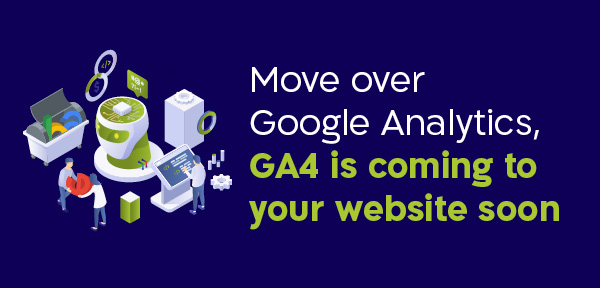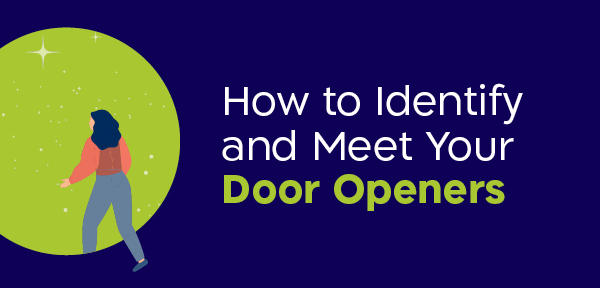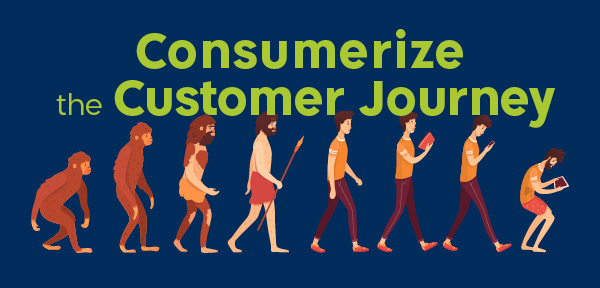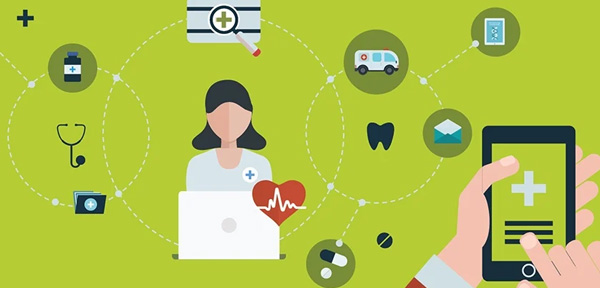The BL[OZ]
Will AI be the death of SEO?
By
Orly Gilad
, 14/06/2023
As ChatGPT gains momentum, concerns are growing regarding its impact on everything from coding to SEO. It depends on who you ask, but the current consensus is that AI is not likely to kill Search Engine Optimization. In fact, it may actually prove quite useful in enhancing and optimizing SEO efforts. AI-powered technologies can provide insights, automate tasks, and improve the efficiency of SEO strategies.
As ChatGPT gains momentum, concerns are growing regarding its impact on everything from coding to SEO. It depends on who you ask, but the current consensus is that AI is not likely to kill Search Engine Optimization. In fact, it may actually prove quite useful in enhancing and optimizing SEO efforts. AI-powered technologies can provide insights, automate tasks, and improve the efficiency of SEO strategies.
 If it’s repetitive and time-consuming, AI has got you covered
If it’s repetitive and time-consuming, AI has got you covered
Why spend time on keyword research, competitor analysis, and content optimization, when you can be focusing on strategic planning and higher-level tasks? Here are three key ways AI can help:
-
Data Analysis
-
Content Optimization
-
Personalization
AI can analyze user data and behavior to deliver personalized search results and content recommendations. This can help improve user engagement and satisfaction, which can indirectly impact SEO rankings.

AI is your assistant, not your replacement
AI can’t replace human expertise in SEO. SEO professionals will still play a crucial role in interpreting and implementing the insights provided by AI, as well as adapting SEO strategies to changing algorithms, user behaviors, and business goals. AI tools can be powerful to support and enhance SEO efforts, but human creativity and strategic thinking will remain crucial in the SEO landscape.How can you utilize ChatGPT for SEO purposes?
Here are its suggestions:- Content Generation: Use ChatGPT to generate ideas for quick content for your website, blog, or social media posts. You can input keywords, topic ideas, or specific questions related to your SEO strategy, and ChatGPT can generate content that aligns with your SEO goals.
- Keyword Research: Utilize ChatGPT to brainstorm and generate keyword ideas for your SEO campaigns. You can input seed keywords or topic ideas, and ChatGPT can generate a list of related keywords that can help you identify opportunities for content creation and optimization.
- Meta Tags Optimization: Use ChatGPT to generate optimized meta tags, including title tags and meta descriptions, that are relevant to your target keywords and audience. ChatGPT can provide suggestions and variations for meta tags that can improve your website's click-through rates (CTRs) and search engine visibility.
- SEO Content Optimization: Input your existing content into ChatGPT to get suggestions on how to optimize it for SEO. ChatGPT can provide recommendations on improving content structure, keyword placement, and readability to make your content more search-engine-friendly.
- On-Page SEO: Use ChatGPT to get suggestions on optimizing various on-page SEO elements, such as headings, image alt tags, and URL structure. ChatGPT can provide insights on how to improve these elements for better search engine visibility and user experience.
- SEO Strategy assistance: Utilize ChatGPT to brainstorm and generate ideas for your overall SEO strategy, including content topics, and social media integration. ChatGPT can provide wide suggestions and insights that can inform your SEO planning and execution.
- SEO Troubleshooting: Input specific SEO challenges or issues into ChatGPT to get insights and suggestions on how to resolve them. ChatGPT can provide troubleshooting tips and recommendations to overcome common SEO obstacles.
 While ChatGPT can provide valuable insights and suggestions for SEO purposes, it's still essential to use human judgment and expertise in evaluating and implementing the recommendations.
SEO best practices may vary depending on your specific industry, audience, and search engine algorithms, so it's crucial to conduct thorough research and consult with SEO professionals to build a comprehensive SEO strategy.
While ChatGPT can provide valuable insights and suggestions for SEO purposes, it's still essential to use human judgment and expertise in evaluating and implementing the recommendations.
SEO best practices may vary depending on your specific industry, audience, and search engine algorithms, so it's crucial to conduct thorough research and consult with SEO professionals to build a comprehensive SEO strategy.
Watch Google's update on Search Generative Experience:
HubSpot – Marketing, ROI, and everything in between
Speaker: Dor Rotschild
Hebrew Webinar - marketing managers and sales managers who want to know what really happens in the connection between the marketing and sales processes in your company, and how the connection contributes to ROI and results.
How to Meet & Influence Your Door Openers
Speakers: Nirit Elyovich and Rivi Kesten
The Door Openers strategy will bring you directly to the key people who will open the door for your company.
Don’t say you didn’t see it coming
In October 2020, Google announced that it would discontinue Universal Analytics and shift to Google Analytics 4 (GA4). But don’t worry, we’ve got you covered with our step-by-step guide on how to switch from Universal Analytics to GA4, discuss the differences between these two versions of GA, and highlight some of the benefits of GA4.
The clock is ticking
From July 2023, the free version of GA will no longer gather data. That means if you want to continue using Google Analytics, you must switch to GA4. Take note, you will be able to access your previously processed data in your Universal Analytics property for at least six months. However, you won’t be able to view your Universal Analytics reports or interact with your analytics data via the API. This change will affect all website owners who rely on their Google Analytics account as their main data source for audience demographics, behavior, and areas of interest.What’s the difference between Google Analytics and GA4?
If you want to know how your users are interacting with your website or app, you need effective event tracking which allows you to track specific user interactions – such as button clicks, video plays, and form submissions. In the past, you needed to set it up manually, adding code snippets to your website or app to track specific events, which was challenging to manage. The good news is that G4 has already set it up for you and you can configure event tracking without coding. While the focus used to be on calculating site sessions and monitoring audiences, it’s now moved to what audiences are actually doing on your site. GA4 offers parameters, enhanced measurement, and in-platform event creation (replacing action, category, and label). When setting up the data stream, you can turn on enhanced measurement to automatically collect page views, downloads, outbound clicks, video engagement, and scrolls. Conditions and parameters (which provide context on the user or user actions) cover events that don’t fall under enhanced measurement. Take note that you can mark events as conversions which eliminate the need for goal setup.There are four types of events covered in GA4:
-
Automatically collected events

-
Enhanced measurement events
-
Recommended events

-
New G44 features
- Link to Google Merchant Center, Google Optimize, and BigQuery natively and for free
- Create custom reports in GA4 and add those reports right to your navigation
- Custom dashboards combining two tools in one —taking the data from UA and Data Studio
Gee, four sounds great!
Switching to GA4 allows you to take advantage of all the new advanced features and get the most out of your data. There isn’t much time left to make the move, so if you haven’t already started, it’s time to make the switch now. Ready to make the switch? Our SEO team will walk you through it.From a Simple PPT to a Winning Presentation
Speakers: Rivi Kesten Buk and Nevo Levin
Practical Tips for PowerPoint Presentations From Oz's Experts
Move over Google Analytics, GA4 is coming to your website soon
By
Orly Gilad
, 17/05/2023
You’re probably familiar with Universal Analytics, the Google Analytics (GA) tool that has been around for more than a decade, providing website owners and publishers with insights into their website’s performance. But in July 2023, it’s being replaced by GA4. Are you ready for the switch?
Don’t say you didn’t see it coming
In October 2020, Google announced that it would discontinue Universal Analytics and shift to Google Analytics 4 (GA4). But don’t worry, we’ve got you covered with our step-by-step guide on how to switch from Universal Analytics to GA4, discuss the differences between these two versions of GA, and highlight some of the benefits of GA4.
The clock is ticking
From July 2023, the free version of GA will no longer gather data. That means if you want to continue using Google Analytics, you must switch to GA4. Take note, you will be able to access your previously processed data in your Universal Analytics property for at least six months. However, you won’t be able to view your Universal Analytics reports or interact with your analytics data via the API. This change will affect all website owners who rely on their Google Analytics account as their main data source for audience demographics, behavior, and areas of interest.What’s the difference between Google Analytics and GA4?
If you want to know how your users are interacting with your website or app, you need effective event tracking which allows you to track specific user interactions – such as button clicks, video plays, and form submissions. In the past, you needed to set it up manually, adding code snippets to your website or app to track specific events, which was challenging to manage. The good news is that G4 has already set it up for you and you can configure event tracking without coding. While the focus used to be on calculating site sessions and monitoring audiences, it’s now moved to what audiences are actually doing on your site. GA4 offers parameters, enhanced measurement, and in-platform event creation (replacing action, category, and label). When setting up the data stream, you can turn on enhanced measurement to automatically collect page views, downloads, outbound clicks, video engagement, and scrolls. Conditions and parameters (which provide context on the user or user actions) cover events that don’t fall under enhanced measurement. Take note that you can mark events as conversions which eliminate the need for goal setup.There are four types of events covered in GA4:
-
Automatically collected events

-
Enhanced measurement events
-
Recommended events

-
New G44 features
- Link to Google Merchant Center, Google Optimize, and BigQuery natively and for free
- Create custom reports in GA4 and add those reports right to your navigation
- Custom dashboards combining two tools in one —taking the data from UA and Data Studio
Gee, four sounds great!
Switching to GA4 allows you to take advantage of all the new advanced features and get the most out of your data. There isn’t much time left to make the move, so if you haven’t already started, it’s time to make the switch now. Ready to make the switch? Our SEO team will walk you through it.It’s not you, it’s Google!
By
Orly Gilad
, 02/05/2023
Did Your Search Engine Rankings Drop Suddenly? It’s Not You, it’s Google! When you’ve worked hard to get your website ranking high in Google’s results, it can be disturbing when they experience a sudden drop. We’d tell you not to panic, but it doesn’t really work. Actually, if you see other webmasters panicking, chances are you should be too.
 A good place to start is the Google Search Console. You’ll find that it’s a valuable tool for tracking and optimizing your website's rankings in Google search results. Take a look at your analytics and check your manual action report.
Making major changes to your site may have an impact on your rankings. Take a look at your website traffic to see if there are any noticeable changes or trends. Reviewing your site statistics may provide some useful data and actionable insights.
By leveraging the information provided by the console, you can make informed decisions and implement effective strategies to improve your website's performance and rankings.
A good place to start is the Google Search Console. You’ll find that it’s a valuable tool for tracking and optimizing your website's rankings in Google search results. Take a look at your analytics and check your manual action report.
Making major changes to your site may have an impact on your rankings. Take a look at your website traffic to see if there are any noticeable changes or trends. Reviewing your site statistics may provide some useful data and actionable insights.
By leveraging the information provided by the console, you can make informed decisions and implement effective strategies to improve your website's performance and rankings.
It’s not you? It could be Google
Google makes updates every single day, a couple of times a day. A Google update in February caused a lot of volatility. Here’s the bad news: experts say Google’s volatility will continue to intensify. Tools such as Semrush Sensor can help with assessing SERP volatility. Remember, SEO is an ongoing process, so ranking fluctuations are inevitable. By monitoring, analyzing, and optimizing your website's performance regularly, you can improve your rankings and drive more targeted organic traffic to your website over time.To stay informed of the up and downs, follow Google Search Status updates, or SEO news sites and blogs.
How to Identify and Meet Your Door Openers
By
Nirit Elyovich
, 26/03/2023
How to Identify and Meet Your Door Openers How can you identify and get to know the people who are in the right position to open the door for you? In a recent webinar, Nirit Elyovich, our VP Strategy, shared some key insights.
- Who are the door openers?
- How can you get to know them better?
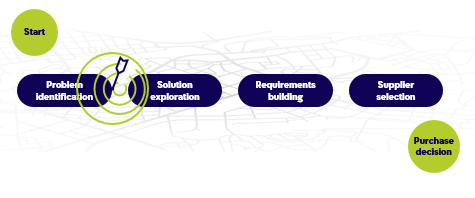 1. Stay as close to the beginning of the purchase journey as possible
The role of marketing is to generate demand. The earlier we meet the interested parties at the beginning of the purchase journey, the more we will increase our chances of entering the consideration set — to be one of the suppliers they are considering.
This is the point when they realize that there is a problem. As the need arises, they begin to learn about the alternatives that exist in the market. It's time for you to enter the picture.
Key takeaway: Find the earliest point in the purchase journey, even before your potential customers start contacting suppliers.
2. Expand your search beyond the obvious and cast a wider net – to influencers and KOLs
Entire industries are undergoing a shake-up and need to update their business strategy. In this scenario, it’s strategic consulting companies that will be recommending new business directions to them. If a high-profile consulting company recommends you, you’ve done your part. Obviously, they won't recommend you if they don't know about you. But if you recognize them as the ones who can open the door for you and you bring your company to their attention, new horizons will open up for you.
If you’re working in the same space with complementary companies, leverage it. As an example, companies in the agritech space are all targeting the same growers. They don’t compete but complement one another. Growers are already working with a company trusts them. If they recommend you, then your chances of setting a meeting and staying to build a relationship, are far greater.
Key takeaway: Differentiate yourself and try to reach your door openers through avenues that others haven’t yet discovered.
3. Copy your ideal customer
Think of a customer of yours that you would like to duplicate. Your potential dream client — the one who, if you get it right, will allow you to duplicate your offer to lookalike clients.
It’s really what a persona is all about — a typical figure that represents your target audience. The idea is to learn from the individual and expand it to a broader audience. If it’s too niche and cannot be replicated, it won't really help you.
Key takeaway: If it works, do it again!
How can you get to know your door openers better?
Each persona has their own "buttons", that when pushed cause them to act. If you know what motivates your door openers, you’ll be able to reach them. That's why it's important to build a profile for each persona you’ve chosen.
1. Stay as close to the beginning of the purchase journey as possible
The role of marketing is to generate demand. The earlier we meet the interested parties at the beginning of the purchase journey, the more we will increase our chances of entering the consideration set — to be one of the suppliers they are considering.
This is the point when they realize that there is a problem. As the need arises, they begin to learn about the alternatives that exist in the market. It's time for you to enter the picture.
Key takeaway: Find the earliest point in the purchase journey, even before your potential customers start contacting suppliers.
2. Expand your search beyond the obvious and cast a wider net – to influencers and KOLs
Entire industries are undergoing a shake-up and need to update their business strategy. In this scenario, it’s strategic consulting companies that will be recommending new business directions to them. If a high-profile consulting company recommends you, you’ve done your part. Obviously, they won't recommend you if they don't know about you. But if you recognize them as the ones who can open the door for you and you bring your company to their attention, new horizons will open up for you.
If you’re working in the same space with complementary companies, leverage it. As an example, companies in the agritech space are all targeting the same growers. They don’t compete but complement one another. Growers are already working with a company trusts them. If they recommend you, then your chances of setting a meeting and staying to build a relationship, are far greater.
Key takeaway: Differentiate yourself and try to reach your door openers through avenues that others haven’t yet discovered.
3. Copy your ideal customer
Think of a customer of yours that you would like to duplicate. Your potential dream client — the one who, if you get it right, will allow you to duplicate your offer to lookalike clients.
It’s really what a persona is all about — a typical figure that represents your target audience. The idea is to learn from the individual and expand it to a broader audience. If it’s too niche and cannot be replicated, it won't really help you.
Key takeaway: If it works, do it again!
How can you get to know your door openers better?
Each persona has their own "buttons", that when pushed cause them to act. If you know what motivates your door openers, you’ll be able to reach them. That's why it's important to build a profile for each persona you’ve chosen.
 Every persona, even in the same organization, is motivated by different things. There’s no single message that motivates everyone. To get a clearer picture, ask yourself these questions:
Every persona, even in the same organization, is motivated by different things. There’s no single message that motivates everyone. To get a clearer picture, ask yourself these questions:
- What tasks need to be done — What is on the decision maker’s plate? Typically, people only listen if it’s in their scope of activity. This is critical!
- What are the aspirations of each persona — What do they want to achieve within their role? In short, what are their “gains?”
- What are their pain points — What makes it difficult to achieve their goals?
 To convince someone to let you in the door, they must be convinced that it will bring significant value both to the company and themselves.
Meir Ariel sings, "The doors guess who I am and open by themselves." It would be great if that was true in the business world, where the doors we are looking don’t recognize us and won’t open by themselves.
Knock, knock, knocking on the right door
To sum up, when you focus on the beginning of the customer journey, expand your view to less obvious places, and know which persona profile you’re looking for, there’s a good chance you will reach the people who can open the door for you. Then all you have to do is enter.
To convince someone to let you in the door, they must be convinced that it will bring significant value both to the company and themselves.
Meir Ariel sings, "The doors guess who I am and open by themselves." It would be great if that was true in the business world, where the doors we are looking don’t recognize us and won’t open by themselves.
Knock, knock, knocking on the right door
To sum up, when you focus on the beginning of the customer journey, expand your view to less obvious places, and know which persona profile you’re looking for, there’s a good chance you will reach the people who can open the door for you. Then all you have to do is enter.
UX/UI trends in the B2B world – What to take & leave behind in 2023
By
Naomi Lifshitz
, 18/01/2023
When I just started my career, an intelligent woman told me that only when I understand.
- What’s on the menu? “When planning the user experience, we have to put ourselves in our users’ shoes. We all have limited time and between work, home, and family, we don't have time to scroll through endless websites in the search for information,” says Naomi.
- Make some space!
- Give the footer the respect it deserves “Just because the footer’s at the bottom of the website doesn’t mean it doesn’t deserve a place of honor,” notes Naomi. “While the footer may be located on the ’fringe’ of the site, we shouldn’t treat it as such. When specifying the site structure every part of the site is important. We’re not going to add unnecessary pages or elements to the site, but the footer appears on every page and needs to be designed accordingly.”When building a brand strategy for businesses, it’s important that it speaks the same language – everywhere it appears – and that includes the footer. Give it space and design it in a brand-compatible manner, incorporating creative brand elements and enticing messaging. Scroll down to Unilog’s footer to see how it reflects the brand’s personality.
- No more excuses! That’s so yesterday “Leave the excuses why you can’t build a website in 2022,” says Naomi, adding that, “Many businesses avoid building a website on the grounds that they don’t have sufficient budget, information, or products to build a complete site. But keeping your website short and to the point puts paid to that excuse.”
Consumerize the Customer Journey
By
Nirit Elyovich
, 25/01/2022
Early in my career, a wise woman said customers pay my salary, not owners. It's vital for marketers to consider future customers' needs.
The new B2B customer is a digital native
Our childhood determines our future behaviors as adults, the people we become, and the decision-makers we grow up to be. It is also true of the technological environment in which we were raised.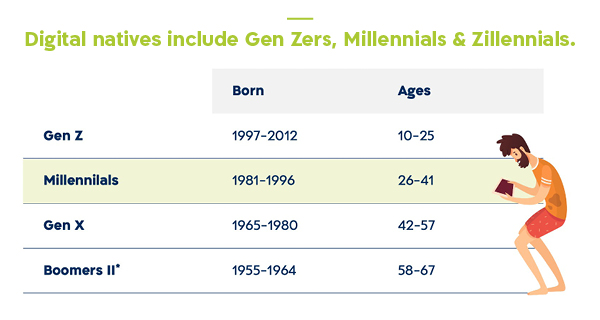 The millennials, also known as Generation Y, were born after 1980. They are now in their 30’s. Generation Z, as you can see in the table, is still young, but we will soon see them influencing our businesses. Since technology is changing very quickly, a sub-generation was born between the Millennials and Generation Z. Zillennials were born between ‘93-‘98 and were influenced by more advanced technology than the Millennials.
For their entire lives, digital natives have been surrounded by technology, social media, mobile devices, computers, and the internet. They speak this digital language as their mother tongue. They did not learn this language in their 20’s, 30’s, or later. They do not have an accent, so to speak.
The millennials, also known as Generation Y, were born after 1980. They are now in their 30’s. Generation Z, as you can see in the table, is still young, but we will soon see them influencing our businesses. Since technology is changing very quickly, a sub-generation was born between the Millennials and Generation Z. Zillennials were born between ‘93-‘98 and were influenced by more advanced technology than the Millennials.
For their entire lives, digital natives have been surrounded by technology, social media, mobile devices, computers, and the internet. They speak this digital language as their mother tongue. They did not learn this language in their 20’s, 30’s, or later. They do not have an accent, so to speak.
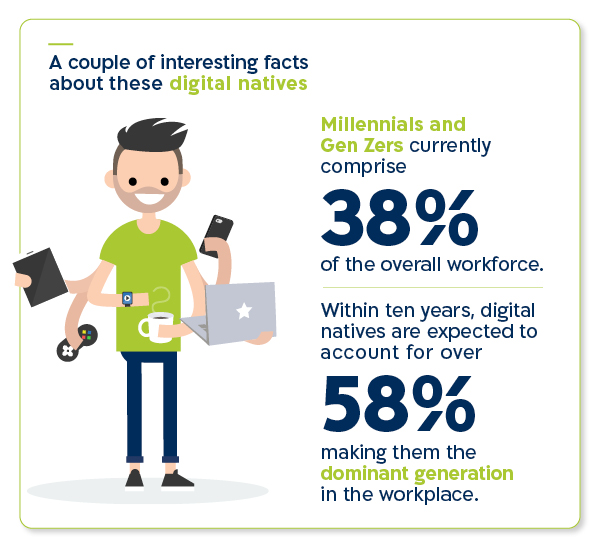
 This impressive figure tells the whole story: More and more millennials and gen zers are entering the B2B decision journey, some as technological or professional influencers and others as decision-makers. It is important to note that among the people involved in decision-making, you usually meet several generations.
A few months ago, we at Oz Global B2B did a project for the American agricultural market. The intergenerational integration in the decision-making process that arose there was very prominent.
This impressive figure tells the whole story: More and more millennials and gen zers are entering the B2B decision journey, some as technological or professional influencers and others as decision-makers. It is important to note that among the people involved in decision-making, you usually meet several generations.
A few months ago, we at Oz Global B2B did a project for the American agricultural market. The intergenerational integration in the decision-making process that arose there was very prominent.
-
- A family business where the younger generation initiates a decision, and the founding generation approves it. Sometimes the founder initiates the decision but immediately passes it on to the younger generation to check online what the options are.
- A senior manager at a big business closes a deal, but the people in the field - professionals or salespeople - do not “speak” the same language. This will greatly affect the next purchase.
The Millennials and Gen Zers highly influence who will enter the decision funnel
About 50% of all product searches on the web are conducted by digital natives. The customer journey is long, complex, and involves many stakeholders.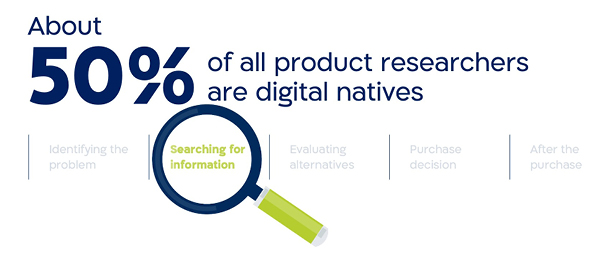 By the time the customer recognizes that he has a problem, we are, in most cases, not there. Identification is an internal stage from which someone is appointed to start researching information to find options for a solution.
50% of those who conduct the research and seek alternatives regarding a product or service, may not take an "official" part in decision-making but are the ones who put the relevant suppliers in the decision-making funnel. They are the ones who build the long list. They are the ones who decide whether or not you will be included in the “consideration group,” which is of critical importance.
By the time the customer recognizes that he has a problem, we are, in most cases, not there. Identification is an internal stage from which someone is appointed to start researching information to find options for a solution.
50% of those who conduct the research and seek alternatives regarding a product or service, may not take an "official" part in decision-making but are the ones who put the relevant suppliers in the decision-making funnel. They are the ones who build the long list. They are the ones who decide whether or not you will be included in the “consideration group,” which is of critical importance.
Two tips to gain the trust of digital natives:
1. Be authentic!
The generation that grew up on social networks, fake news, and unfounded marketing does not believe in marketing messages and does not believe in unproven statements. They have developed a hypersensitivity to online messages - they suffer from a blatant lack of trust in what is being said online. They continue to consume information online, but with a very large firewall. The bright side of it is that digital natives recognize authenticity when they see it..So what does authentic marketing look like?
-
- Get your executives to use social media Customers want to know the people behind the executives or the company representatives that they are in contact with.Make sure your site reveals who you are beyond your formal title. What topics do you choose to share? Who are your friends, what groups do you belong to, and to whom do you respond to?LinkedIn is not everything. Feel free to diversify to other social networks - Facebook, Instagram, Twitter, and even Tik Tok.
- Share user-generated content from real people Show real things, with real customers behind them. If you trust your product, let it tell your story.
- Go live on social media platforms Talk without filters. To digital natives this sounds obvious, to digital immigrants, it is less trivial. At first, the digital immigrants posted posts after editing them numerous times. Then they agreed to post an edited video. The transition to live video is scarier, but this is exactly the meaning of authenticity.
- Promote employee advocacy Empower your employees to share smart, quality content with their own social networks. On average, employee networks have 10x more connections than a company has followers. Plus, according to the Edelman Trust Barometer, people are 3x more likely to trust company information shared by an employee than that shared by a CEO.
2. Consumerize!
This word does not exist in the dictionary yet but already stars in the literature that follows trends in the B2B world. As Mona Akmal, Falkon CEO and Cofounder, once said, “As work and life flexibly intertwine, so must our approach to reaching our target users.” Gone are the days when the customer was a business person between 9-17 and a consumer on evenings and weekends. Studies show that the business customer is very much influenced by his consumer experience and expects to have a similar experience in business purchases. The customer experience touches on all stages of the journey - collecting information, placing an order, contacting the company up to paying.- More than 80% of B2B customers stated that they will look for a new supplier if their expectations in terms of customer service and user experience are not fulfilled.
- According to McKinsey & Co, B2B brands score below 50% on customer experience index ratings on average, compared to 65 to 85% for typical B2C brands.
- Gartner illustrates that 77% of B2B buyers report that their last purchase was very difficult or complex.
To sum up…
- The digital natives are digital animals. They were born into it, and it is their playground. It requires us to be present and comfortable in the digital space. Allow them to find us easily and learn about us in a convenient way that interests them. Allow them to easily consult, purchase and pay online.
- Life in the digital arena has taught them to be suspicious, not to believe everything they are told. They have developed the skills and expertise to recognize fake news when they see it. This requires us to be authentic in interactions with them, without filters and edits.
- Remember, before they are decision-makers, customers, or partners, they are first and foremost human beings. Their personal lives have seeped into their business life and it is very difficult for them to separate the two. So, we have no choice but to "consumerize" the way we treat them.
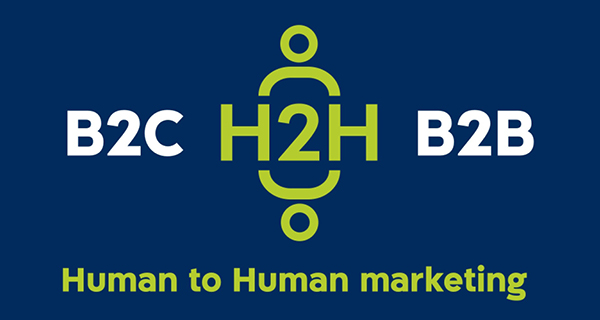
How to Get Started with B2B Videos
By
Liane Shalev
, 26/09/2019
When’s the last time you watched a video? Today? Yesterday?
Key takeaways from HUG Haifa #2, “All About Video”
When’s the last time you watched a video? Today? Yesterday? That puts you in good company. Humans love video. 1/3 of all time online is spent watching videos. In fact, 500 million people watch a video on Facebook every day. And here’s another mindboggling stat for you: Adding a video to your website can improve the chance of a front-page Google result by 53%. That’s right. It doubles your chances of getting onto the first page of Google. Yes, video is big. Yes, it needs to be an important part of your B2B marketing strategy. And no, it’s not nearly as hard as you think to get started with video.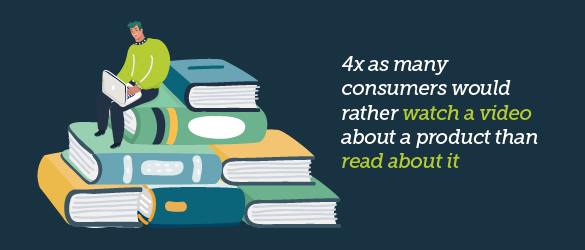 From tactic to strategy
Video has changed a lot in the past six years, points out Maria Trubicina, Senior Customer Success Manager at HubSpot. In 2013, videos were mostly passively watched on desktop or YouTube, hard to create and made by a few; in 2019, videos are actively watched on mobile or social, easy to create, and made by many.
This calls for a change – moving from video as a tactic (made by a creative team, highly produced, expensive, one to many, an awareness play, unmeasurable), to a strategy (made by all teams, low production, cheap, actionable, BOFU and measurable.)
Listen up!
To create relevant, actionable and engaging videos you need to get all your teams involved. That means talking to sales, quality control, production, legal, and even accounts. Every department will have a unique perspective about your product or service that you may not have even thought of. One video does not fit all. Each video needs to be tailored to the specific target market and goal. Make it simple. And keep it real.
What kind of videos should you be creating?
You’ll need to develop targeted videos for every stage of the flywheel and for every purpose – attract, engage and delight – and modify them to meet the needs of the specific channel (YouTube, social media, website).
From tactic to strategy
Video has changed a lot in the past six years, points out Maria Trubicina, Senior Customer Success Manager at HubSpot. In 2013, videos were mostly passively watched on desktop or YouTube, hard to create and made by a few; in 2019, videos are actively watched on mobile or social, easy to create, and made by many.
This calls for a change – moving from video as a tactic (made by a creative team, highly produced, expensive, one to many, an awareness play, unmeasurable), to a strategy (made by all teams, low production, cheap, actionable, BOFU and measurable.)
Listen up!
To create relevant, actionable and engaging videos you need to get all your teams involved. That means talking to sales, quality control, production, legal, and even accounts. Every department will have a unique perspective about your product or service that you may not have even thought of. One video does not fit all. Each video needs to be tailored to the specific target market and goal. Make it simple. And keep it real.
What kind of videos should you be creating?
You’ll need to develop targeted videos for every stage of the flywheel and for every purpose – attract, engage and delight – and modify them to meet the needs of the specific channel (YouTube, social media, website).

- Attract videos expand reach and build trust and credibility with your audience.
- Engage videos convert your visitors into leads and ultimately close them as customers.
- Delight videos encourage customers to embrace your brand and become brand evangelists.
- Increase brand awareness and attract customers to your site
- Help your prospects consider your solution to solve their problem
- Help your leads decide to do business with you
 Where do you get the content from?
Chances are, you already have it. Take a look at your existing content. Which web pages were visited the most? What calls to action did users click on? What blogs were the most successful? Repurpose them into compelling stories. But make sure your video answers the key question your potential customers at the Attract and Engage stage are going to ask before deciding to watch or ignore your video: What’s in it for me? How are you solving MY problems?
Hold it! Don’t make these three mistakes.
Video content specialist Sivan Felder, from Two Heads Consulting, points out that many B2B companies make these mistakes:
Where do you get the content from?
Chances are, you already have it. Take a look at your existing content. Which web pages were visited the most? What calls to action did users click on? What blogs were the most successful? Repurpose them into compelling stories. But make sure your video answers the key question your potential customers at the Attract and Engage stage are going to ask before deciding to watch or ignore your video: What’s in it for me? How are you solving MY problems?
Hold it! Don’t make these three mistakes.
Video content specialist Sivan Felder, from Two Heads Consulting, points out that many B2B companies make these mistakes:
- You’re not the hero of the story. This isn’t about you. It’s about your customer (the hero) who has a crisis. He meets a guide (your company). And thanks to your product or service, he survives or thrives.
- The laws of human psychology apply to your target customer as well. Behind every rational purchasing decision is an emotion. Identify it and speak to it. Help your prospective customers out of confusion and into clarity. And remember to tell them what they need to hear (as opposed to what you want to say.)
- A one-size-fits-all video. We’ve already said it, but we’ll say it again. Your customers want to hear different things from you at different stages. What are the touchpoints? Where are customers going to come into contact with your video and how are you planning to get your video out there?
- Play rate — the percentage of people who played your video divided by the number of impressions)
- Clickthrough rate — the number of times your call to action is clicked divided by the number of times its viewed
- Conversion rate — the number of times your visitors completed your desired action divided by the number of clicks on your call to action
- Make your videos an interactive experience. Use smart CTAs and embedded forms.
- Increase SEO effectiveness. Finetune your meta info to make it easy for search engines to find you.
- Monitor performance. Keep track of your video views, clickthroughs and conversions, so you can optimize them accordingly.
- Build relationships. Record one-to-one videos directly from the CRM and send directly from email.
- Provide better customer service. Use videos to improve the service experience and provide helpful tips or troubleshooting advice.
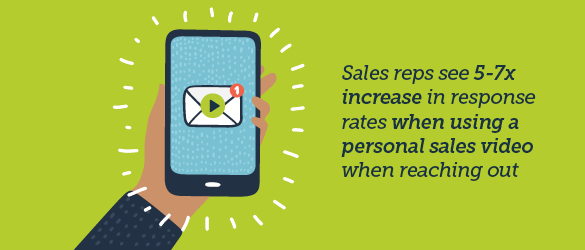 Video goes way beyond creating awareness and nurturing leads. It can also help you build relationships and excel in customer service.
Ready? Hit record!
If you have HubSpot and want to get started with video marketing, contact us!
Don’t miss out! Join a HUG
These great tips are just a taste of what we talked about during our HubSpot User Group meeting, All About Videos. HubSpot makes it easy to make video an integral part of your marketing mix. Take advantage of all these great resources. Get some practical advice on how to get started with video marketing. Or take one of HubSpot’s great free video courses.
Video goes way beyond creating awareness and nurturing leads. It can also help you build relationships and excel in customer service.
Ready? Hit record!
If you have HubSpot and want to get started with video marketing, contact us!
Don’t miss out! Join a HUG
These great tips are just a taste of what we talked about during our HubSpot User Group meeting, All About Videos. HubSpot makes it easy to make video an integral part of your marketing mix. Take advantage of all these great resources. Get some practical advice on how to get started with video marketing. Or take one of HubSpot’s great free video courses.
HUG Haifa – SALES & MARKETING ALIGNMENT
By
Jonathan Cohen
, 08/08/2019
The HUG Haifa debut was a triumph. We gained insights from HubSpot's Stephen Fuery and BERMAD's Ofir Marx, which will advance our Marketing and Sales projects.
- 87% Of the terms sales & marketing use to describe each other are negative
- 20% - The amount of revenue increase companies with strong sales & marketing are able to achieve.
- I don’t know if the sales team is working my leads
- I don’t know the ROI of my marketing campaigns
- I’m getting too many leads and can’t prioritize them
- I don’t know what to do with these Marketing leads.
Service Level Agreement (SLA)
This is a commitment between Marketing & Sales to deliver on specific goals. How do you create an SLA? Glad you asked 😊. Use Historical data to understand your goals, putting into consideration the common goals between the two teams. Ask yourself these questions as a roadmap to creating an SLA that serves both the marketing and sales teams:- How many MQL’s is Marketing creating?
- Are Sales working MQL’s?
- At what rate are MQL’s converting to Customers?
- What % of deals are attributed to Marketing?
Decide on future SLA’s and build reports to measure them, presenting SMART (Specific, Measurable, Actionable, Relevant, Timely) goals.
Let’s compare: Goal 1: I want more website visitors, leads and sales. But this is too general, what about? Goal 2: I need 20,000 visitors, 500 leads, 12 customers within 12 months in order to achieve our revenue goal of $600,000 from Inbound. Goal 2 is a SMART goal. It will give you a complete picture of what you want to achieve.Agree on Fit
This is a measurement of how well you could serve a lead if they were to become a customer.Segmentation:
Let’s divide segmentation into two parts:- Lifecycle stage: a way of categorizing where any given contact or company is within your marketing and sales flywheel.
- Lead Scoring: Lead scoring is a methodology used by sales and marketing to determine the worthiness of leads or potential customers by attaching values to them based on performance.
- Publishing professional blogs, case studies, and white papers
- Sending out nurturing emails to leads
- Posting on social media
- Using marketing automation to convert a lead to SQL
- Increase involvement in LinkedIn discussion groups
- Target campaigns in specific locations
- Blog in other languages
- Introduce Account Based Marketing activities.
Can Inbound Marketing Really Impact on Your Bottom Line?
By
Orit Oz
, 08/03/2019
Bermad, a kibbutz-based company manufacturing water control valves, built itself into a successful global concern from the ground up.
The conversation has changed: From top down to two-way communication
“Today, we can communicate directly with customers,” says Marx. “In the past, our way of communicating with customers was top down. HQ communicated to its subsidiaries, who communicated to the dealers, who in turn, communicated to the end users. We never got direct feedback, and even if we did, it had passed through three to four different hands and got filtered along the way. That’s changed. Now by publishing blogs, case studies, and white papers, sending out emails, and posting to social media, we have the ability to deliver messages directly to the end user and get feedback.“
Generating leads, assessing quality
Leads are collected on landing pages with targeted calls to action (CTAs). By asking qualifying questions, Bermad is able to assess the quality of the leads received. The results show that 35% are sales qualified leads (SQL), 30% are marketing qualified leads (MQL), and the balance are service requests, spare parts or vendors looking to sell the company something. In short: More than 60% leads are relevant enquiries.Key goals versus results
At the beginning of the process, Bermad set some goals:- Increase site traffic to 20,000 Moved from 12,000 to 20,000 website visitors per month in less than 2 years
- Generate 500 leads per month Approximately 200 leads per month now and it’s rising
- Added Revenue of $1,000,000 per year Reached $700,000 in 2017; anticipate higher in 2018
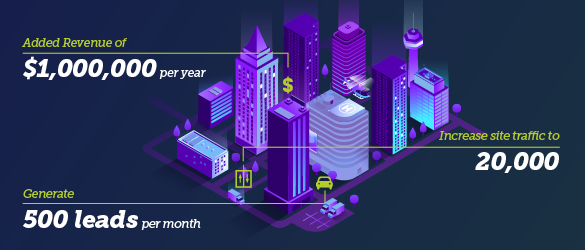
Are we getting it right?
The ability to speak directly to the marketplace and understand what they are interested in and what questions they ask, enables the company to understand whether they need to do anything differently.What’s next?
Marx believes that the awareness and exposure that is being gained is very important, and it’s only the beginning. There’s still much to be done, from increased involvement in Linked In discussion groups to targeted campaigns in specific locations, as well as blogging in other languages such as Spanish and Portuguese.Leveraging the power of marketing automation
The company is just beginning to benefit from the powerful marketing tools available on HubSpot including lead scoring and nurturing. Having tripled the amount of contacts, there is a wealth of potential customers to cultivate, taking them from the awareness and consideration stages through to making the decision to purchase.It takes time, effort and investment
Today, all Bermad’s divisions are involved, with 4-5 people at HQ contributing to content creation as well as support from professionals at the company’s various subsidiaries. Blogs are published on a monthly basis for all four segments (waterworks, irrigation, fire protection and building & construction), supported by email blasts, newsletters and ongoing social media posts. Campaigns are run to support product launches, exhibitions and special events. All marketing activities are integrated into Bermad’s CRM system, allowing the sales team to see a 360° view of potential customers and enabling them to close more deals. “Today, nobody asks why we are doing it,” notes Marx. “We’re just beginning to see the benefits.”How To Grow Your Business Using the Flywheel
By
Ilan Amit
, 23/01/2019
That’s when the real growth happens.
 Simply put, the top of the funnel (TOFU) is where you build awareness about your company and the problem you address, the middle of the funnel (MOFU) is where you teach people how to choose a solution, and the bottom of the funnel (BOFU) is where you explain why your product is the best solution.
The funnel has a major weakness: It doesn’t take into account that the people coming out of the bottom of the funnel can have a major impact on the people going into the top of it — in fact, people at the bottom of the funnel can feed those going into the top of the funnel.
Conversely, the people leaving the bottom of the funnel can prevent other people from entering the top of the funnel.
Simply put, the top of the funnel (TOFU) is where you build awareness about your company and the problem you address, the middle of the funnel (MOFU) is where you teach people how to choose a solution, and the bottom of the funnel (BOFU) is where you explain why your product is the best solution.
The funnel has a major weakness: It doesn’t take into account that the people coming out of the bottom of the funnel can have a major impact on the people going into the top of it — in fact, people at the bottom of the funnel can feed those going into the top of the funnel.
Conversely, the people leaving the bottom of the funnel can prevent other people from entering the top of the funnel.
 The attitude of people when they come out of your funnel has a direct impact on the number of people who are willing to enter the top of the funnel.
The attitude of people when they come out of your funnel has a direct impact on the number of people who are willing to enter the top of the funnel.
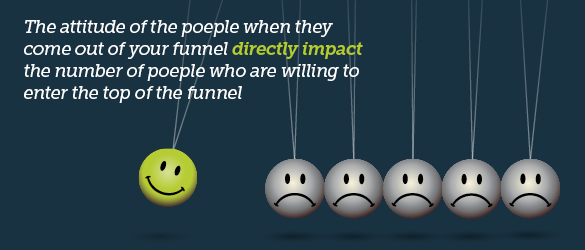
The Flywheel as a Growth Engine for Your Business
Funnels produce leads. What they don’t do is help you close the leads, keep your customers happy, or take advantage of the customers you’ve already acquired to help you grow. That’s where the flywheel comes into play and the inbound marketing methodology helps it spin.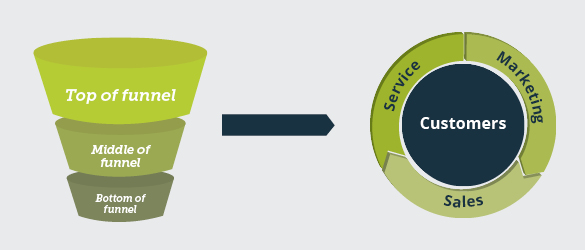
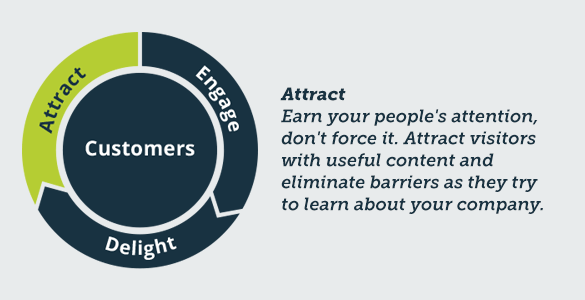 The rotating flywheel represents the growth of your business. Happy customers help fuel your growth. How? By buying from you again, or bringing new customers to you by promoting your product to their extended network of colleagues, friends or family.
“The rotation of the flywheel represents the growth of your business, and happy customers provide the energy that fuels that growth.”
Kyle Jepson, Hubspot Academy
All your marketing activities should be focused on creating customers who will inject good energy into the flywheel and speed up your company’s growth.
The rotating flywheel represents the growth of your business. Happy customers help fuel your growth. How? By buying from you again, or bringing new customers to you by promoting your product to their extended network of colleagues, friends or family.
“The rotation of the flywheel represents the growth of your business, and happy customers provide the energy that fuels that growth.”
Kyle Jepson, Hubspot Academy
All your marketing activities should be focused on creating customers who will inject good energy into the flywheel and speed up your company’s growth.
Combining Funnels and Flywheels
While the flywheel represents your company as a whole, funnel charts can help you improve a particular aspect of your business performance, for example, your sales funnel. Analyzing it can help you understand where you’re losing customers along the way. When your entire company starts thinking about accelerating the flywheel as a whole instead of focusing on improving individual funnel metrics, major strides can be made. That’s when the real growth happens.Rebranding – so much more than just a logo or color palette
By
Miri Peled
, 19/02/2018
Rebranding – so much more than just a logo or color palette. What you'll need to do when rebranding.
Refresh or rebrand?
When rebranding, you can either refresh and improve your current branding or start over and create an entirely new one. No matter what you decide, the rebranding process involves a lot more than designing a new logo or changing your corporate color palette. Here’s what you’ll need to do:- Defining a clear rebranding strategy.
- Reanalyzing your company’s vision, mission and values.
- Conduct market research and competitor research including new players who may have popped up more recently.
- Research existing customers, potential customers and target audiences.
- Redefine your message.
- Create a new visual identity.
- Create new marketing materials.
- Relaunch your brand (internally and externally).
Spreading the news
The rebranding journey can sometimes be confusing for your employees and customers who have become accustomed to your existing brand identity. Use this as an opportunity to reconnect with them and clearly communicate during the process and after its completion. If you want the transition process to be a success, you should be as transparent as possible and clearly communicate these changes both internally and externally.Rebranding with OZ
At OZ, we understand the complexity of rebranding and our team has extensive experience helping our customers successfully navigate the rebranding process. We can use this experience to successfully guide you through it from planning through to implementation and beyond.10, 9, 8…. And counting down marketing trends for 2018
By
Orit Oz
, 18/01/2018
The New Year is here and we put together a countdown of marketing trends that will affect B2B brands in 2018!
10 – Visual content
 The trend for visualization through video, images and infographics will get stronger. In fact, predictions indicate that by 2019, video will account for 80% of consumer internet traffic. And, according to Facebook, live is even better and live video gets 3x more views and is expected to dramatically increase in 2017. B2B brands can use live videos in lots of different ways, including at events to give followers a behind-the-scenes look, host interviews with key influencers, and launch promotions.
The trend for visualization through video, images and infographics will get stronger. In fact, predictions indicate that by 2019, video will account for 80% of consumer internet traffic. And, according to Facebook, live is even better and live video gets 3x more views and is expected to dramatically increase in 2017. B2B brands can use live videos in lots of different ways, including at events to give followers a behind-the-scenes look, host interviews with key influencers, and launch promotions.
9 – Big (big) data
 Big data’s been a big trend for many years now, but it’s become more accessible because of machine learning and AI. As more and more platforms and marketing methods start incorporating big data, the use of big data is becoming an essential part of marketing and understanding what the consumer wants and when is worth its weight in gold.
Big data’s been a big trend for many years now, but it’s become more accessible because of machine learning and AI. As more and more platforms and marketing methods start incorporating big data, the use of big data is becoming an essential part of marketing and understanding what the consumer wants and when is worth its weight in gold.
8 – Authenticity
 Transparency and trust have become a major component of the customer’s decision-making process as customers’ become less and less tolerant towards fake news and reviews, or in other words, exaggerated marketing. Brands should invest in community management to keep the online community engaged, informed and happy; and can use technology advances such as virtual reality (VR) and augmented reality (AR) to connect with users on a deeper, more emotional level.
Transparency and trust have become a major component of the customer’s decision-making process as customers’ become less and less tolerant towards fake news and reviews, or in other words, exaggerated marketing. Brands should invest in community management to keep the online community engaged, informed and happy; and can use technology advances such as virtual reality (VR) and augmented reality (AR) to connect with users on a deeper, more emotional level.
7 – Content and influencer networks
 There is no arguing with the fact that content is still king. However, there is a need to deal with the challenge of oversaturation. Now that most brands have some sort of content strategy and social media networks are full of content, the focus needs to shift slightly. Rather than fighting for more visibility, marketers will need to think out of the box and stand out in space that is already taken. This is where influencers come into the picture. By leveraging the networks of influencers who already have a “captive” audience, marketers can increase their online influence and start to reduce the volume of content produced, or in other words, go for quality and not quantity.
There is no arguing with the fact that content is still king. However, there is a need to deal with the challenge of oversaturation. Now that most brands have some sort of content strategy and social media networks are full of content, the focus needs to shift slightly. Rather than fighting for more visibility, marketers will need to think out of the box and stand out in space that is already taken. This is where influencers come into the picture. By leveraging the networks of influencers who already have a “captive” audience, marketers can increase their online influence and start to reduce the volume of content produced, or in other words, go for quality and not quantity.
6 – Shift of focus from millennials to Generation Z
 Born between 1995 and 2010, this consumer group marks a substantial shift that will affect all brands. These digital natives are different from millennials and they will have increased buying power in the near future. Keep an eye out on key platforms such as Snapchat and Instagram when targeting this young and highly dynamic demographic.
Born between 1995 and 2010, this consumer group marks a substantial shift that will affect all brands. These digital natives are different from millennials and they will have increased buying power in the near future. Keep an eye out on key platforms such as Snapchat and Instagram when targeting this young and highly dynamic demographic.
5 – Mobile, mobile, mobile
 We cannot emphasize this one enough. Consumers are spending most of their time on their mobile phones. In fact, in 2018, mobile video consumption is expected to grow by 25% and ad spending on mobile video will reach 18 billion dollars next year, surpassing desktop. Even Google has even given priority to pages that are AMP optimized (Accelerated Mobile Pages). So the bottom line is that if you haven’t yet done so, you need to start optimizing your marketing strategies, websites and ads for mobile.
We cannot emphasize this one enough. Consumers are spending most of their time on their mobile phones. In fact, in 2018, mobile video consumption is expected to grow by 25% and ad spending on mobile video will reach 18 billion dollars next year, surpassing desktop. Even Google has even given priority to pages that are AMP optimized (Accelerated Mobile Pages). So the bottom line is that if you haven’t yet done so, you need to start optimizing your marketing strategies, websites and ads for mobile.
4 – Shift in KPIs
 While it’s still important to know how many people visited your site and from where, at the end of the day it’s all about sales. For this reason, it’s important to track conversions and revenue, in other words, who buys and at what stage of the buyer’s journey. In this way, it becomes easier to track your return of investment on digital marketing.
While it’s still important to know how many people visited your site and from where, at the end of the day it’s all about sales. For this reason, it’s important to track conversions and revenue, in other words, who buys and at what stage of the buyer’s journey. In this way, it becomes easier to track your return of investment on digital marketing.
3 – Data protection
 The digital age brings with it the need to take multiple aspects including data privacy into account. In May 2018, the General Data Protection Regulation (GDPR) will take affect with the aim of improving protection for EU citizens and adapting privacy and data laws to the digital age. This will require marketers to think and act very differently as it will affecter multiple factors in a marketer’s focus, some of which require organizations to start preparing immediately.
The digital age brings with it the need to take multiple aspects including data privacy into account. In May 2018, the General Data Protection Regulation (GDPR) will take affect with the aim of improving protection for EU citizens and adapting privacy and data laws to the digital age. This will require marketers to think and act very differently as it will affecter multiple factors in a marketer’s focus, some of which require organizations to start preparing immediately.
2 – Native ads and smart content
 Native advertising is expected to drive more than 74 percent of all add revenue by 2021. Because of their more natural placement and format, these ads usually get more exposure and engagement than traditional banner ads. However, these ads need to be written according to the preferences of those seeing the ads, and they should also be linked to “smart content” that is adapted to audiences based on NI, cookies and an in-depth understanding of target audiences.
Native advertising is expected to drive more than 74 percent of all add revenue by 2021. Because of their more natural placement and format, these ads usually get more exposure and engagement than traditional banner ads. However, these ads need to be written according to the preferences of those seeing the ads, and they should also be linked to “smart content” that is adapted to audiences based on NI, cookies and an in-depth understanding of target audiences.
1 – Take advantage of the FOMO effect
 Even though we already mentioned this one in a previous point, we think it deserves to be repeated for emphasis. As more and more people experience the FOMO (Fear of Missing Out) effect, marketers need to create unique and original content that makes potential customers feel like they’re the first to know. For example, content that involves a “behind-the-scenes look”, an exclusive with an influencer, or a sneak preview of upcoming projects and product launches can be used to really create a buzz and get potential consumers to engage “before” anyone else does.
Even though we already mentioned this one in a previous point, we think it deserves to be repeated for emphasis. As more and more people experience the FOMO (Fear of Missing Out) effect, marketers need to create unique and original content that makes potential customers feel like they’re the first to know. For example, content that involves a “behind-the-scenes look”, an exclusive with an influencer, or a sneak preview of upcoming projects and product launches can be used to really create a buzz and get potential consumers to engage “before” anyone else does.
Opportunities for Israeli B2B companies looking to China
By
Mike Golden
, 01/01/2018
Israel and China are a perfect match – China is an incredible opportunity for Israeli cyber-security, medical devices and artificial intelligence industries.
How to break into the Chinese market:
Understand the target customer and other stakeholders Find the right strategic partners to help you. Consumers in China are entirely different than what you are used to. They are on different channels, they have different expectations, and there are important cultural norms you’ll want to be aware of. A local team on the ground with the experience and tools to understand and effectively target customers is crucial to preventing big blunders. Regulatory concerns It is critical to spend time researching and understanding the regulatory environment prior to making any decision to enter the market. China has extremely strict laws protecting consumers, including quality, standards and other regulations covering most industries. Sensitive industries such as medical devices and pharmaceutical are especially strict. Trademark everything, immediately As soon as your product comes on the scene in China you can bet there will be copycats. We’ve seen it with big brands and small, if you don’t take trademarking seriously, you run the risk of expensive, messy and prolonged legal battles. Before talking to anyone, start the trademark process and make sure you own the corresponding Chinese domain names (.cn and .com.cn). Don’t assume what works in the West will work in China Look no further than eBay and Uber, two remarkably successful international companies that failed in China. Chinese consumers have different tastes, different expectations, different cultural norms and customs that are deep-rooted in society. On top of all of this is an unrelenting drive for innovation, which makes brands with a weak positioning strategy extremely vulnerable. If you take your brand to the China market and your messaging is unclear, or your branding is weak, there is a good chance your product or service will be copied and eaten up by a domestic brand. Find a decent Chinese name It doesn’t have to be a direct translation, or even exactly the same as the Western version. The Mandarin language is comprised of thousands of characters that all have a great deal of significance. Meaning there are lots of options for translations that can turn out great, or translations that can turn out… not so great. AirBnB fell prey to a naming mishap when they entered the Chinese market as 爱彼迎 (Àibǐyíng), which they explained means “let love meet each other” but to native Chinese this name conjures up images of a “love hotel”, and many complained that it is awkward to pronounce. Even if you think you’ve settled on a great name, test it, test it and test it again. Start with distribution and expand from there You don’t need to set up shop right away. After you’ve trademarked everything, going through a distributer to test the waters is a good way to enter the China market. Many SME’s in the medical industry routinely work with distributors to get their products into hospitals in China. Set up your website Number one piece of advice; put your Chinese website on a server in China or Hong Kong. Shrinking attention spans haunt every content marketer, so don’t lose your audience even before your beautifully, well-crafted home page loads. If you are hosting on a local Chinese server you are required to apply for the ICP license and this also means you need to have a local entity already organized. You’ll typically need to apply for an ICP license from the Chinese Government; this will lead to better search results on Baidu and allows you to run PPC campaigns. Don’t forget to make your website mobile optimized! In China more than 95% of Internet users are using their mobile phones to access it. Choose the right trade shows This goes hand-in-hand with understanding your target customer and stakeholders. There are hundreds of trade shows in China every year, with thousands of exhibitors. It can be tempting to try and get your foot in the door to as many as possible, but this will leave you out of budget and exhausted quickly. Can you team up with similar brands? Make connections with attendees beforehand? Enter social media with your big toe in the water With all the hype around WeChat in China, many brands are ready to dive headfirst and go all out for this mega-app, but take a step back. WeChat is completely different than Facebook, Instagram or any other typical social media platform you are familiar with using. It is important to set the right expectations, and the right strategy. Become well versed with the app, it’s functionality and it’s limitations before setting your KPIs. While it is important for brands to have a WeChat account, there may be other channels to investigate.Moo-ving it up a notch with user experience
By
Miri Peled
, 10/10/2017
To encourage Afimilk’s dealers to make more purchases online and to give them access to marketing materials, OZ designed an intuitive online partner portal.
Afimilk case study: partner portal
In the world of B2B, it’s really important to nurture partner relationships and find ways to make it easier for our partners and distributors to satisfy the needs of their (and our) end customers. In this manner, you can create a win-win situation where both your customers (distributors) are happy and their customers (end users) are happy with your brand. Recently, as part of our ongoing services for Afimilk – a global leader in advanced dairy management technology solutions – we created a unique and creative solution for its partners. With the goal of encouraging Afimilk’s dealers to make more purchases online and give them easy access to marketing materials, we designed an integrated and intuitive online partner portal. This portal provides end-to-end marketing and sales support, and an easy-to-use online ordering system. It includes three valuable tools that are also integrated with Afimilk’s ERP system:- Knowledge center – with marketing resources including brochures, presentations, and supporting materials to help dealers promote Afimilk solutions.
- Configurator wizard – builds price quotations tailored to customer requirements while promoting Afimilk’s preferred solutions.
- Market gate – intuitive online ordering system tailored for Afimilk partners to encourage online ordering.
Moving to a business-to-business-to-user mindset (B2B2U©)
By
Dina Gidron
, 10/09/2017
Communicate with both intermediary customers and patient-consumers in this new age of healthcare by transitioning to a Business-to-Business-to User model.
It’s all about the people and building relationships
By
Miri Peled
, 09/08/2017
We worked together to develop a new visual identity that stands out in the global market and is also centered around Trendlines’ two foundational principles.
It’s about the people AND building relationships
Because Trendlines Group’s hands-on investment approach and commitment to improve the human condition through innovation are inseparable parts of the company's character, the refreshed visual identity rests strongly on these principles. The result – a new compelling brand and visual identity – was launched at Trendlines’ 7th Annual Trendlines Company Showcase attended by hundreds of biomedicine industry professionals from around the world, and sponsored by companies worldwide.Inbound for Medical & Healthcare Companies Event
By
Miri Peled
, 23/07/2017
We held an Inbound for Medical & Healthcare Companies event where industry experts shared multiple insights on marketing for medical and healthcare industries.
- Matt Brown, HubSpot Specialist from Boston – US Trends in Healthcare Marketing
- Dina Gidron, VP Strategy at OZ – Opening New Channels of Communication
- Mickey Nave, Corporate Marketing Director at Lumenis – Medical marketing: generating leads that your sales team will love
- Bat-chen Grinberg, Founder of MC Forum – Digital tools that reduce your work overload
- The age of “Social Health”. The combination of healthcare reforms, the age of consumerism and mobile technology is creating the perfect climate for change in healthcare.
- We see YOU, we know YOU, we understand YOU, we want to help YOU. The digital revolution is transforming the way we do business as we shift from a Business-to-Business (B2B) to a Business-to-Business-to-User (B2B2U©).
- Patient-consumers are the center of the universe. As patient-consumers become the single most important factor in this new era, we need to open up direct channels of communication with them to understand their challenges, increase brand awareness and create bottom-up demand.
- Trends in medical and healthcare. Patient-consumers are avid researchers; marketers are targeting patient-consumers AND payers; digital channels are overtaking traditional marketing channels; and digital content is key to the decision process.
- Brands must recognize social health and deliver value across the full spectrum to drive leads, convert prospects to customers and keep them loyal.
- Inbound marketing and content marketing are well-suited to the medical and healthcare industry as it promotes targeted communication, trust-based decision-making, long-term relationships, and thought leadership and industry expertise.
Getting to know your patient-consumers
By
Orit Oz
, 13/07/2017
When I just started my career, an intelligent woman told me that only when I understand.
Preparing for the age of “Social Health”
As healthcare reforms, the era of consumerism and mobile technology create the ideal climate for positive change in the medical and healthcare arena, we’re ushering in a new age – the “Social Health” era. As we transition into this new era, patient-consumers are becoming the single most important factor in the medical and healthcare eco-system; and as they research and shop online for medical services, products and insurance plans, the medical & healthcare industry increasingly resembles a retail industry. The impact of this shift on medical and healthcare providers is huge as it means they need to open up direct channels of communication with patient-consumers to understand their challenges and offer services and products with real value. Or in other words, there is a need to move from a Business-to-Business (B2B) to a Business-to-Business-to-User (B2B2U©) approach.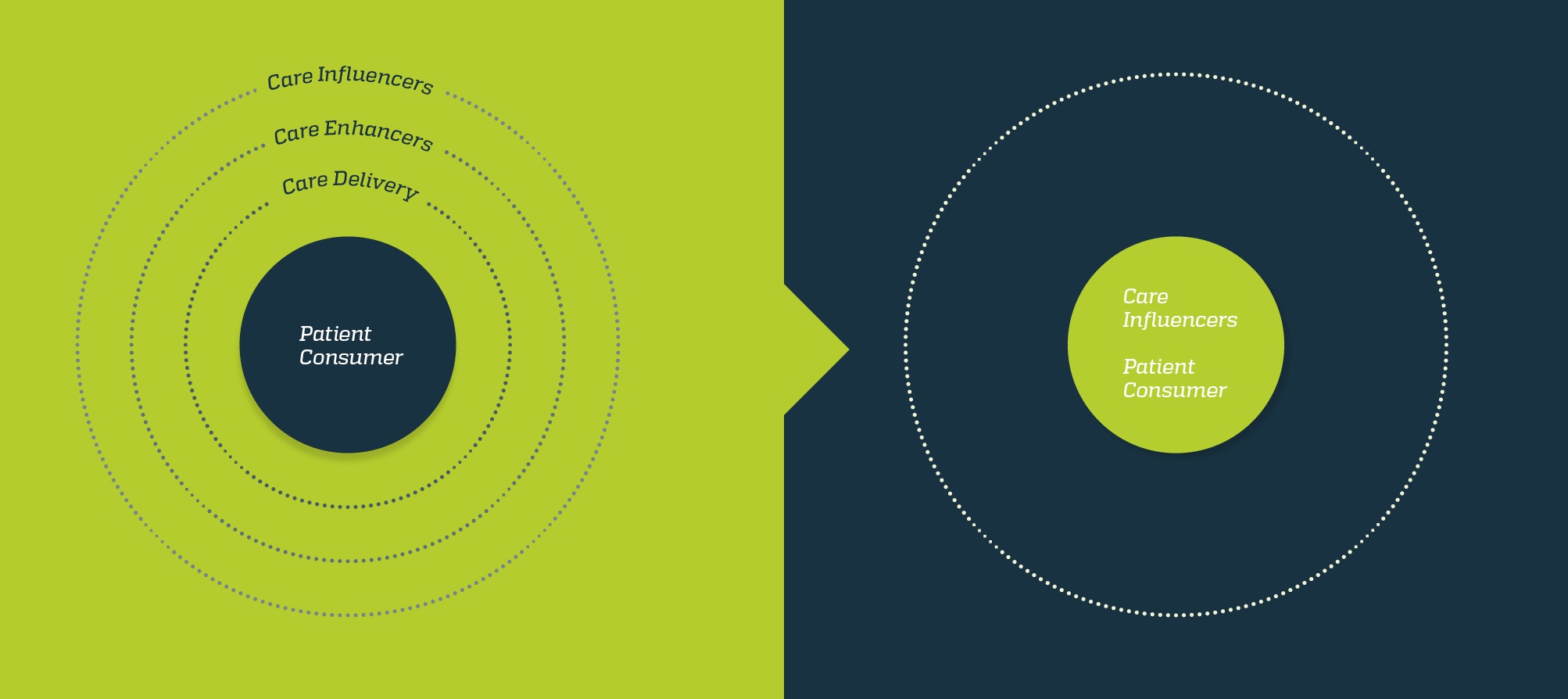 As we enter this age of “Social Health”, brands need to recognize the need to deliver value across the full spectrum to drive leads, convert prospects to customers and keep them loyal.
As we enter this age of “Social Health”, brands need to recognize the need to deliver value across the full spectrum to drive leads, convert prospects to customers and keep them loyal.
What’s the difference between traditional and inbound marketing?
By
Miri Peled
, 29/06/2017
Inbound marketing focuses on attracting customers through valuable content, while traditional marketing is marketer-centric and uses more interruptive methods.
It's time to attract your prospects instead of bombarding them.
Inbound marketing is a customer-centric approach that focuses on attracting customers to your business through content and interactions that are valuable, helpful, and trust-building.It’s all about using remarkable content to develop and nurture long-term relationships with your prospects so they ultimately build trust in your brand.
In comparison, traditional marketing, which is marketer-centric, uses more interruptive methods to vie for the attention of prospects.| Inbound | VS. | Outbound | |
| Definition | Inbound marketing uses customer-centric tactics to attract prospects, address their challenges and goals, and build trust in your business | Traditional marketing uses more interruptive methods to push products and services and get the attention of prospects | |
| Communication | Based on interactive communication that engages prospects and attracts them to you | Based on one-way, outward communication | |
| Tools/techniques | Educational content such as blogs, videos, eBooks, white papers, SEO, and case studies | Print and TV ads, banner ads, direct mail, cold calling, and mass email campaigns | |
| Goals | Offer prospects value through educational content and earn their trust | Drive sales through product-centric marketing |
Get your creative juices flowing with these great blog topic tips
By
Orit Oz
, 06/06/2017
Here are some tips to get your creative juices flowing to come up with some great blog topics.
- Consider the content’s purpose, format and topics.
- Create content that builds trust amongst your prospects.
- Get your content in front of the right people at the right time.
- Analyze & repeat. Determine what worked and what didn’t, and repeat your successes.
What is lead nurturing?
By
Orit Oz
, 24/05/2017
Lead nurturing is the process of engaging with contacts via automated workflows to build a relationship with them.
- Grow and nurture relationships
- Offer educational content
- Use hyper personalization

























